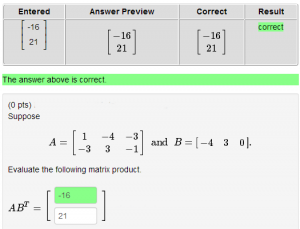Difference between revisions of "MatrixAnswer1"
Paultpearson (talk | contribs) m |
(add historical tag and give links to newer problems.) |
||
| (3 intermediate revisions by one other user not shown) | |||
| Line 1: | Line 1: | ||
| + | {{historical}} |
||
| + | |||
| + | <p style="font-size: 120%;font-weight:bold">This problem has been replaced with [https://openwebwork.github.io/pg-docs/sample-problems/LinearAlgebra/MatrixAnswer1.html a newer version of this problem]</p> |
||
| + | |||
| + | |||
<h2>Answer is a Matrix 1</h2> |
<h2>Answer is a Matrix 1</h2> |
||
| Line 6: | Line 11: | ||
</p> |
</p> |
||
* File location in OPL: [https://github.com/openwebwork/webwork-open-problem-library/blob/master/OpenProblemLibrary/FortLewis/Authoring/Templates/LinAlg/MatrixAnswer1.pg FortLewis/Authoring/Templates/LinAlg/MatrixAnswer1.pg] |
* File location in OPL: [https://github.com/openwebwork/webwork-open-problem-library/blob/master/OpenProblemLibrary/FortLewis/Authoring/Templates/LinAlg/MatrixAnswer1.pg FortLewis/Authoring/Templates/LinAlg/MatrixAnswer1.pg] |
||
| + | * PGML location in OPL: [https://github.com/openwebwork/webwork-open-problem-library/blob/master/OpenProblemLibrary/FortLewis/Authoring/Templates/LinAlg/MatrixAnswer1_PGML.pg FortLewis/Authoring/Templates/LinAlg/MatrixAnswer1_PGML.pg] |
||
<br clear="all" /> |
<br clear="all" /> |
||
| Line 79: | Line 85: | ||
<p> |
<p> |
||
<b>Setup:</b> |
<b>Setup:</b> |
||
| − | The MathObject matrices are constructed using the <code>Matrix()</code> constructor. |
||
| + | Use <code>Context("Matrix");</code>. |
||
| + | MathObject matrices are constructed using the <code>Matrix()</code> constructor. |
||
The matrix A has two rows and three columns, and is constructed by <code>[ [row 1 entries], [row 2 entries] ]</code>, and this construction generalizes in the obvious way. |
The matrix A has two rows and three columns, and is constructed by <code>[ [row 1 entries], [row 2 entries] ]</code>, and this construction generalizes in the obvious way. |
||
If a matrix has only one row, such as B, then it is entered as <code>[row 1 entries]</code> and <b>not</b> as <code>[ [row 1 entries] ]</code>. |
If a matrix has only one row, such as B, then it is entered as <code>[row 1 entries]</code> and <b>not</b> as <code>[ [row 1 entries] ]</code>. |
||
Latest revision as of 06:23, 18 July 2023
This problem has been replaced with a newer version of this problem
Answer is a Matrix 1
This PG code shows how to evaluate answers that are matrices.
- File location in OPL: FortLewis/Authoring/Templates/LinAlg/MatrixAnswer1.pg
- PGML location in OPL: FortLewis/Authoring/Templates/LinAlg/MatrixAnswer1_PGML.pg
| PG problem file | Explanation |
|---|---|
|
Problem tagging: |
|
DOCUMENT(); loadMacros( "PGstandard.pl", "MathObjects.pl", "AnswerFormatHelp.pl", ); TEXT(beginproblem()); |
Initialization: |
Context("Matrix");
$A = Matrix([
[random(-5,5,1),random(-5,5,1),random(-5,5,1)],
[random(-5,5,1),random(-5,5,1),random(-5,5,1)],
]);
$B = Matrix([random(-5,5,1),random(-5,5,1),random(-5,5,1)]);
$answer = $A * ($B->transpose);
|
Setup:
Use |
Context()->texStrings;
BEGIN_TEXT
Suppose
\[
A = $A
\ \ \mbox{and} \ \
B = $B.
\]
Evaluate the following matrix product.
$BR
$BR
\( A B^T = \)
\{ $answer->ans_array(5) \}
\{ AnswerFormatHelp("matrices") \}
END_TEXT
Context()->normalStrings;
|
Main Text:
Use the |
$showPartialCorrectAnswers = 1; ANS( $answer->cmp() ); |
Answer Evaluation: Use standard MathObject answer evaluation. |
Context()->texStrings;
BEGIN_SOLUTION
${PAR}SOLUTION:${PAR}
Solution explanation goes here.
END_SOLUTION
Context()->normalStrings;
COMMENT('MathObject version.');
ENDDOCUMENT();
|
Solution: |
